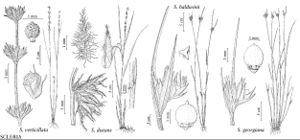Scleria verticillata
Sp. Pl. 4(1): 317. 1805.
Plants annual; rhizomes absent; roots reddish, fibrous. Culms solitary or in tufts, erect, slender, (7–) 10–60 cm, glabrous. Leaves: sheaths green or streaked with purple, smooth or weakly ribbed, usually narrowly winged, long-villous; contraligules minute; blades linear or filiform, plane or keeled, shorter than culms, 0.5–2 mm wide, glabrous. Inflorescences terminal, glomerate-spicate, 2.5–13 cm; glomerules 2–9, erect, brown, compact, 3–7 mm wide, each with 5–12 (–15) spikelets; proximal glomerules occasionally on short, erect peduncles; rachis glabrous; bracts subtending inflorescence bristlelike, minutely ciliate or glabrous, inconspicuous. Spikelets bisexual, alternate, often appearing cyclic or whorled, 2–3 (–4) mm; scales oblong-lanceolate. Achenes whitish or often gray or brownish or with dark interangular markings, trigonous-globose, 1–1.5 (–1.9) mm, base trigonous, stipelike, short, narrowly constricted, and somewhat pitted or ribbed, apex distinctly mucronate, surface transversely tuberculate with quadrate ridges; hypogynium obsolete, represented by narrow brownish ridge at base of achene.
Phenology: Fruiting summer–fall.
Habitat: Wet, marly, sandy, or peaty soils in marshes, bogs, savannas, moist meadows, wet pinelands, and lakeshores
Elevation: 0–400 m
Distribution

Ont., Ala., Ark., Conn., Del., Fla., Ga., Ill., Ind., Iowa, La., Md., Mich., Minn., Miss., Mo., N.J., N.Y., N.C., Ohio, Okla., Pa., S.C., Tenn., Tex., Va., Wis., West Indies (Bahamas), West Indies (Cuba)
Discussion
Scleria verticillata has very close affinities with S. hirtella and S. tenella Kunth. It is relatively wide-ranging, extending along the Gulf and Atlantic coasts and inland to the Great Lakes, where it remains a very distinct species. At its southern limit in the West Indies, it tends to merge with both S. hirtella and S. tenella, producing intermediate forms and blurring its specific boundaries.
Selected References
None.
Lower Taxa
"shortened" is not a number.
